Pros
Cons
Testing / Performance
With each camera we review, we test the camera's color accuracy and measure its variance from the ideal using a GretagMacbeth color chart and Imatest Imaging Software. The modified color chart below expresses these results. For each color tile, the outer square is the camera's reproduced color, while the interior square is the color-corrected tone and the small, vertical rectangle in the center is the ideal.
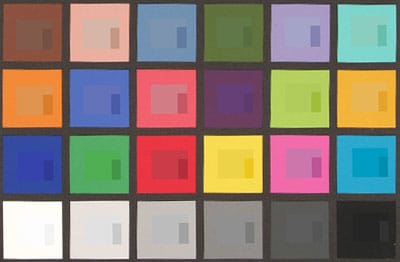
The graph below portrays the Fuji FinePix E550's color reproduction capabilities using the 24 tones of the color chart, represented with both circles and corresponding squares. The circles are the tones produced by the camera, while the linked squares signify the ideal. The longer the length of the line connecting the two, the greater the error for that color.
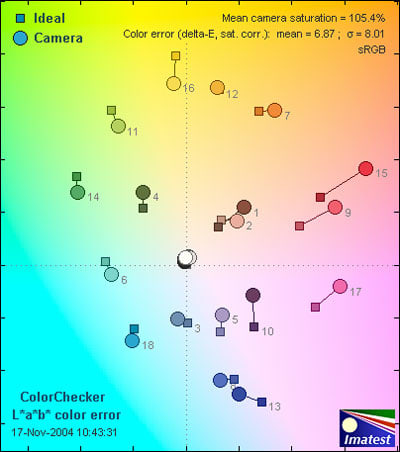
The Fuji FinePix E550 received an overall color score of 7.4, indicating strong color accuracy and naturalistic representation of tones. As you can see in the chart above, few of the produced tones are 'spot on,' however, most do not stray too significantly from their ideal. The E550 earned an 8.01 overall mean color error score, which is very high. This score reflects the averaged variance from each tone and indicates the overall accuracy of the camera. The camera's accurate representation of color is facilitated by minimal over-saturation of hues, an element greatly exaggerated on many digital cameras. The subtle shades produced by the FinePix E550 result in a realistic overall representation of scene and naturalistic portrayal of color.
**Still Life Scene
**Below is a shot of our artistically brilliant still life scene photographed with the Fujifilm FinePix E550.
[

Click on the above image to view a full resolution version (CAUTION: the linked file is very large!)](../viewer.php?picture=Fuji-E550-Still-LifeLG.jpg)
**Resolution / Sharpness ***(4.95)*
To test the resolution of the Fuji FinePix E550, we recorded a series of exposures of our ISO resolution chart, taken at various settings to maximize the camera's performance. We imported the images into Imatest Imaging Software to determine the true pixel count within each image. When this is done, there is always some variance between the camera's marketed pixel count and the actual number of pixels used to record exposures. Cameras that record 70-79 percent of the largest image size are considered 'good' performers, while cameras that score 80-89 percent are perceived as 'very good' and any camera that exceeds 90 percent is 'excellent.'
The Fuji FinePix E550 recorded 4.95 pixels consistently in its images. This is 81 percent of the advertised pixel count and an impressive score. The E550 is one of the most consistent imagers we have tested, repeatedly recording images that exceed the 80 percent mark. This is a strong resolution score for any camera, but is particularly remarkable considering the E550 can be found online for under US$300.
**Noise - Auto ISO ***(2.89)*
The Fuji FinePix E550 appears to falter when shooting in the camera's automatic ISO mode, producing an abundance of discernible noise. This is a major performance flaw of the E550 because the majority of the camera's users are likely to be automatic, point-and-shoot snapshooters. Unfortunately, users of this variety will have to make the effort to set the camera's ISO sensitivity, as the E550 does contain alterable ISO settings. If they do not do this, they will have to endure the distortion that is sure to accompany many images that are recorded without the use of the camera's flash.
**Noise - Manual ISO ***(7.09)*
When manual ISO settings are offered on a camera, we test the perceivable noise at each ISO rating using Imatest Imaging Software. We put the results into a regression analysis to determine an overall manual noise score. The graph below illustrates the results, with the horizontal X-axis plotting the ISO ratings and the vertical Y-axis depicting the produced noise.

The FinePix E550 received a 7.09 overall manual score. This is a dramatic improvement over the camera's ability to handle noise in automatic ISO mode; however, the score does indicate that additional lighting may be needed in certain instances to reduce the possibility of noise-ridden images. The E550's noise levels were nearly identical in the ISO 400 and ISO 800 settings, despite the 800 setting only being available in the 3MB image quality setting.
**Speed / Timing
***Start-up/First shot (8.48)*
Taking 1.52 seconds to turn on, orient itself to the shot and capture the image, the FinePix E550 is unexpectedly quick for a point-and-shoot camera and blows away most competing models within its price range.
**
Shot to shot(8.61)
Successive shooting speeds on the E550 are also quite rapid, recording consecutive images in 1.39 seconds. This is amply speedy for most casual events and should even be adequate for some subsequent motion captures. Again, this is impressive speed for a sub-$300 point-and-shoot camera.
**
Shutter to shot(8.44)
The Fujifilm FinePix E550 takes just 0.28 seconds to record an image from the time the shutter release is depressed. This is extremely responsive and rivals the speed of nearly all non-SLR digital cameras. The rapid shutter to shot time dramatically reduces shutter lag and will cut down on the possibility for unwanted movement blurring the image after the shutter is released.
Physical Tour
**
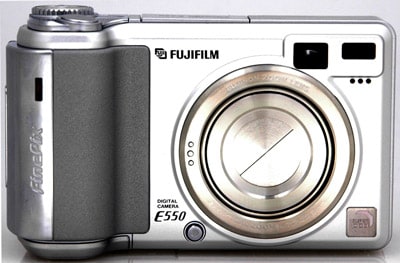
Front (7.5)** The front of the Fujifilm FinePix E550 is mostly comprised of the 4x optical zoom lens in polished silver, which appears on the right half of the camera body. The left half features a grip pad, which extends from the rest of the camera body to allow for easier handling during shooting. In the upper right corner of the camera face are the Flash control sensor and Viewfinder window, each in a position that allows the fingers of the left hand to cover it and compromise the image quality. Underneath the Flash sensor, and also placed for optimum masking-by-fingers, is the microphone. Running along the base of the camera body, to the right of the lens ring, is the Adapter ring release button, which allows the user to remove the lens ring and use a different lens. The Self Timer lamp is on the left side of the camera body, on the extension of the right-hand grip.
**
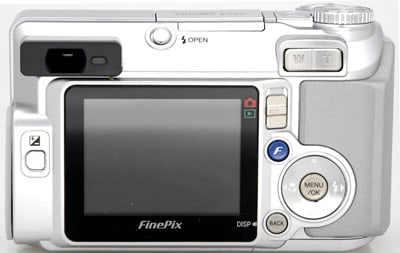
Back (8.0)**
On the back of the Fujifilm FinePix E550, the most noticeable feature is the attractive 2-inch LCD screen, framed in a black square. The left side of the camera has a series of facets that allow for the screen to stand out from the camera body on a different plane than either the EV level button to the left of it or the viewfinder and viewfinder lamp located above and in the upper left corner. The series of slanted surfaces presents a somewhat cluttered and conflicting appearance.
To the right of the LCD screen is a Mode Switch that allows the user to switch quickly between Photography and Playback modes. Beneath that is the "F" button which, when in Photo mode, allows the user to select the quality level, sensitivity, and FinePix Color settings. In playback mode, that switch specifies the print order settings. To the right of the LCD is the four-way controller. The left-arrow button allows the user to turn the Macro on and off, and the right-arrow button engages and sets the flash setting. When these controls are used during Playback, the user can scan between frames or, if viewing movies, activate the movie frame advance feature. At the center of the four-way controller is the 'Menu / OK' button, which brings the user into the menu and selects features. The 'Back/Disp' button beneath the four-way controller stops a procedure partway through, or engages and disengages the LCD display. In the upper right corner of the camera body are the wide angle and telephoto zoom controls.
**

Left Side (5.5)**
The port cover on the left side of the Fujifilm FinePix E550 is removed by pulling the tab away from the camera body. The cover is not attached to the body of the camera, making it a good candidate for getting lost. This is a design drawback, which is completely without merit. There is no logical explanation for a completely detachable port cover. Underneath the port cover, the user will find the A/V out, USB, and DC in ports for the camera. The left side also has a speaker for playback of captured audio.
**

Right Side (8.0)**
There is not much here but a portion of the right hand grip pad and an embedded eyelet for the optional wrist strap.
**

Top (7.5)**
Most of the controls available on the top of the camera body are on the right side. At the front, positioned over the extended right hand grip, is the shutter button for the Fujifilm FinePix E550. Behind, and slightly to the right of the shutter button is the mode dial for the camera, which allows the user to select from Auto, Portrait, Landscape, Sports, Night Scene, Programmed Auto, Shutter Priority Auto, Aperture Priority Auto, Manual, and Movie modes. The power button for the camera is to the left and slightly forward. In the center, on the slanted surface between the top and the back of the camera body, is the button that causes the flash to emerge from its recessed position. Pressing the flash back into the camera body is a delicate and worrisome process, with the potential for breakage always present.
Components
**Viewfinder ***(4.5)*
The viewfinder for the E550 is, like that on many digital camera models, poorly designed. Positioned in the upper-left corner of the camera body, this feature has only 77 percent accuracy when compared with the final image. Furthermore, on top of this low accuracy rating, the fully extended lens barrel for the camera blocks the lower left portion of the window, making it almost impossible for the user to accurately gauge an image sighted through the viewfinder. This lack of consideration is aggravating on a camera with so many good features and specs; the small details of design appear to have been overlooked.
**
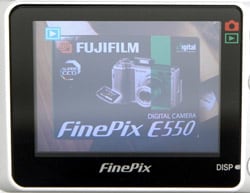
LCD Screen (7.5)**
The LCD screen on the back of the Fujifilm FinePix E550 is nicely sized and framed in black. It is 2.0 inches diagonally measured and has a pixel count of 154,000.
Flash ***(2.5)***
The flash can be set by the user of the Fujifilm FinePix E550 in any mode, save the movie and landscape modes, by pressing the right arrow on the four-way controller once the flash button has drawn the flash from its recessed position in the camera body. Auto Flash, Red-Eye Reduction, Forced Flash, Slow Synchro, Red Eye+Slow Synchro, and Suppressed Flash are all available. The flash appears to be of fairly poor make; during use, extreme care was needed when pushing the flash back into the camera body for fear of breaking components or other hardware. It is as delicate as a kindergartener's loose tooth and could easily jam or malfunction if uneven or awkward pressure were placed upon the unit. Handle with care.
**

Zoom Lens (7.5)**
The Fujifilm FinePix E550 has a 4x optical zoom lens available, with a digital zoom rated up to 6.3x, depending on image quality and size. It has a rating of f/2.8 to f/5.6, with variable focal lengths ranging from 7.2 to 28.8mm. This is equivalent to a 32.5-130mm lens in 35mm format.
Design / Layout
**Model Design / Appearance ***(7.5)*
The crisp design of the Fujifilm FinePix E550 starts with its square frame with rounded edges. There is a sizable right hand grip protruding out from the camera body that’s been covered with a light gray textured surface. Another section covered with the same material is found on the back of the camera body where the right-hand thumb rests. Although it feels nice, I’m not sure whether these actually enhance the user’s grip on the camera or just attract dirt and sweat from the user’s hands.
**Size / Portability ***(7.0)*
The Fujifilm FinePix E550 fits in the hand comfortably, but the weight of the camera (including the two AA batteries) and its body style definitely impedes the camera from fitting into a pocket. Most features on the E550 are flush with the camera body, making them less likely to be accidentally engaged or caught on clothing.

**Handling Ability ***(6.5)*
The E550 by Fuji feels solid in the user’s hands, and it is heavy enough to convey a sense of solidity without feeling overly weighty during lengthy shooting. Once shooting is done, the longer frame and a thicker body make transportation of the Fujifilm FinePix E550 more difficult than transporting the sleeker, more slender digital camera models. The fingers of the right hand can easily reach the controls on the right side of the camera body; however, the flash button in the upper center portion on the back is inaccessible without readjustment and wasted time. The viewfinder is undersized, and the barrel of the zoom lens is visible when viewing through this window frame. This flaw compounds the already inaccurately framed image that will result once the photo is captured.
**Control Button / Dial Positioning / Size ***(6.5)*
Although most of the buttons on the Fujifilm FinePix E550 are of an appropriate size and positioned for simple access, this camera has a few problematic elements. The mode dial is small and attractive, but the grip along its side is not pronounced enough to allow for simple engagement, which causes the thumb of the right hand to slip. The flash button is located on a slant that moves from the top of the camera to the back, and it is placed so that the user must either move the left hand completely or mask the LCD screen while fumbling for it. The "ring" style employed with the four-way controller is a bit tight and some less dexterous users may find themselves frustrated.
**Menu ***(8.0)*
When the menu button is pressed, the LCD displays the menu as a transparent color overlay with the live image behind it. In Automatic mode, the menu allows the user to select from the Self Timer speed, Burst Mode, and Options settings. However, once the camera is in full Manual mode, the user can also select White Balance, Focusing Mode, Photometry, Exposure Compensation, Sharpness, and Flash. The user can also control the Shutter Speed and Aperture Settings for the camera in Manual mode. The menus themselves are straightforward, with full-word descriptions and pop-up submenus with simple layouts.
**Ease of Use ***(7.5)*
This camera clearly lays out mode dial settings and an abundance of manual controls not normally available on a point-and-shoot digital camera model. With the exception of relegating the ISO settings to the "F" menu, the menus with their real-time live background were straightforward and easy to navigate. The four-way control, however, is a bit undersized, and the viewfinder was rendered entirely useless when blocked by the zoom lens. Lastly, the two-inch LCD screen was easy to see and did not suffer from terrible solarizing – a blessing, when the viewfinder cannot be trusted.
Modes
**Auto Mode ***(7.5)*
When the Fujifilm FinePix E550 is placed in automatic mode, the user can utilize the menu to select the Self Timer Setting, Burst Mode, and Options Settings. Flash settings are still manually controllable, the zoom distance is still manual, and from within the "F" button menu the user can still select the Image Quality, the ISO, and the color mode.
**Movie Mode ***(8.5)*
In movie mode, the E550 is capable of capturing continuous audio and video footage at a rate of 30 fps, with quality selections of 640 x 480 and 320 x 240. The amount of video footage is limited only by the size of the memory card. Unfortunately, it is not possible to engage the zoom once recording has begun, so preparation is essential.
**Drive / Burst Mode ***(7.0)*
Continuous, or burst, mode is also available on the E550, and can be found in the continuous shooting subsection of the on-screen menu. When selected, the user can choose among top-four-frame, auto-bracket, final-four-frame, and long-period continuous shooting. Top-four shoots at intervals of .3 seconds; bracketing shoots the image at three separate exposure settings with settings of +/-1/3, +/-2/3, or +/-1 EV. The final-four setting allows for the shutter to be released up to 40 times, at up to .3 seconds/frame, and will record the last four frames. Long period allows for up to 40 continuous frames at .6 second intervals, at a pixel ratio of 1600 x 1200.
**Playback Mode ***(6.0)*
To begin Playback mode, the user must switch the camera mode switch to the play arrow in green. Once engaged, it is possible for the user to view images one at a time, manually or automatically. Even more desirable is the trim option that is available in playback mode. It is possible to enter the menu, select the trimming setting and, through pressing the T and W on the zoom control, select an appropriate playback digital zoom setting. Once the proper portion of the image is highlighted in the frame, the user merely presses the Menu/Ok button to save the cropped image.
**Custom Image Presets ***(5.0)*
There are a handful of custom image presets available to the user of the Fujifilm FinePix E550, but far fewer than on many similar models. The E550 appears to offer advanced manual control within its bracket; however, the camera does sacrifice some automatic or preset preferences to make that possible. These are available through the Mode Dial, and include Portrait, Landscape, Sports, and Night Scene modes. It would have been nice to see some of the more specific preset options included that many cameras now seem to employ, such as glass, fireworks, candle settings, etc. These specific presets are what makes the situational settings advantageous to users.
Control Options
Manual Controls
There are a number of manual controls available to the user of the Fujifilm FinePix E550, but not all of them are easy to access or quickly defined. The user can control manual focus, ISO, white balance, exposure, metering, shutter speed, sharpness, and flash level. Some of these controls are only partially controllable, and all but the ISO are accessible through the regular menu located in the four-way controller.
Focus
***Auto Focus(7.5)*
Automatic focus on the FinePix E550 is rendered very quickly and gives the user the opportunity to both swiftly view and record focused images. There are several different Auto Focus settings available on the camera. When the user sets the camera to Manual, Aperture, Shutter, and Programmed auto modes, he or she can alter the focus settings of the camera. The settings in the subsection are AF Area, AF Multi, and AF Center. AF Center focuses the camera in the center of the frame within the onscreen brackets. AF Multi allows the user to focus the camera on a contrasting subject outside the center of the frame and will display the frame over the focused subject. With AF Area, the user can place the frame within the LCD screen as desired using the four-way controller. None of these effects are visible through the viewfinder window. With the continuous auto focus setting, the camera will constantly adjust to user movement, depleting power from the battery all the while.
Manual Focus*(2.5)*
The pseudo-manual focus on this Fuji is accessible through the Focus sub-menu. When engaged, the user must press the EV +/- button on the back of the camera, while using the wide angle and telephoto zoom controls to adjust focus settings. The focus adjustment on this camera is smooth and efficient, and is better suited for slower shots, as it does take a fair amount of finesse to settle the focus properly. In general, I don't understand why point-and-shoot manufacturers are intent on providing a manual focus feature, which like the small, novelty viewfinders are just made to augment the features description on the box. Bottom line is that any photographer who values manual focus deserves a focus ring. Fumbling with +/- controls will generally be too tedious and cumbersome to make it worth the user's time. It seems as though the effort would be more useful if directed towards improving the camera's autofocus or towards including a true manual focus feature such as a focus ring on a slim, compact frame; otherwise, why waste the time?
**Metering ***(6.5)*
The metering control on the Fuji FinePix E550 is found within the Photometry submenu. (It’s an appropriate term, but one bound to confuse many users of the E550.) The camera has an overall Average setting, Spot metering, and Multi modes. Multi mode registers the light in several areas throughout the frame, while Spot allows for specific and articulated light metering, enabling the user to select specific portions of the frame to expose for.
**Exposure ***(7.0)
*Exposure control settings are controllable through three different modes on the Fujifilm FinePix E550, which are Programmed auto, Shutter-priority auto, and Aperture-priority auto modes. The exposure compensation setting is not available in the Manual mode; there is no good explanation for this. The user can engage the EV button to the left of the LCD screen and press the left or right arrows to display the — or + engagement of this setting. Thirteen steps are available between -2 and +2 EV, in 1/3 EV increments.
**White Balance ***(8.0)*
The white balance settings are found in the regular menu on the FinePix E550. However, unlike many of the controls, they aren’t labeled with clear descriptive words or numbers, instead reverting to a symbolic system of representation. Unfortunately, the icons aren’t intuitive and take some explanation from the manual, but once decoded they allow for preset settings of Auto, Custom, Outdoors, Shade, Daylight Fluorescent, Warm White Fluorescent, Cool White Fluorescent, and Incandescent Lighting. While most competing models will employ basically the same preset options as the FinePix E550, the key distinction here is the custom white balance setting. This feature is essential to digital photography, in terms of both accurate portrayal of the scene as well as offering creative freedom that is unique to the digital and video realms. The E550 is one of the few cameras within this price category to offer the custom white balance setting.
**ISO ***(8.0)*
For some reason, the ISO settings for the Fujifilm FinePix E550 are located in the "F" menu. The user can choose from settings of Auto, 80, 100, 200, 400, and 800. This is an expansive array of setting for a sub-$300 point-and-shoot model, offering settings both below ISO 100 and beyond ISO 400. While the ISO 800 rating is only offered at reduced quality (up to 3 MP quality,) it still provides added flexibility to the shooter. The E550 provides a wide a range of sensitivity options available within this price bracket.
**Shutter Speed ***(6.0)*
Shutter Speed is controllable on the Fujifilm FinePix E550 and accessible through the Shutter-priority auto setting as well as in full Manual mode. By pressing the up and down arrows on the four-way controller, the user can dictate shutter speeds ranging between 3 seconds and 1/1000th of a second. The range offered on the E550 is not too expansive, although it does provide enough shooting flexibility for the user to stop motion as well as extend the duration of the shutter to add illumination or capture the often aesthetically-sought motion blur.
**Aperture ***(7.0)*
Aperture, like shutter speed, is customizable on the Fujifilm FinePix E550, and is engaged by turning the Mode Dial on the top of the camera body to the Aperture-priority auto or full Manual modes. To alter the F-stop settings, the user can use the arrows to toggle within the f/2.8 to f/8 range, offered in 1/3 EV increments for the Wide Angle lens, and f/5.6 to f/8 in 1/3 EV increments when in the Telephoto setting. This range will allow the point-and-shoot user the opportunity to expand their depth of field in full wide angle mode with the f/8 setting, as well as narrow the planes of depth within the frame to create a flat telephoto appearance that also acts as another means for the user to control focus and the viewer's focus within the frame.
Image Parameters
**Picture Quality/Size Options ***(7.0)*
The picture quality and size options are controlled through the 'F' menu on the FinePix E550 and allow for recorded pixel ratio settings of Fine (4048 x 3040), Normal (4048 x 3040, 2848 x 2136, 2048 x 1536, or 1600 x 1200), and Economy (640 x 480). When the camera is set to movie mode, the user can select between 640 x 480 and 320 x 240 resolutions, both recording at 30 frames per second.
**Picture Effects Options ***(4.0)*
The user of the Fujifilm FinePix E550 can choose from three picture effect settings: standard, black-and-white, and "chrome" (used to heighten contrast and color saturation), which are all located within the "F" menu.
Connectivity / Extras
Connectivity
Software*(6.0)*
The Fujifilm FinePix E550 comes with image editing software for both Windows and Macintosh computer platforms.
*

Jacks, ports, plugs (6.5)*
There are three ports available on the E550: the DC in 3V for power, the Audio/Video out port, and the USB port. It should be noted that they are located beneath an unattached port cover on the left side of the camera. In anticipation of the lost port cover, the company has enclosed a backup cover, which will also be promptly lost.
*Direct Print Options (7.0)
*This camera by Fujifilm is capable of direct printing, and may be connected to any PictBridge compatible printer. The user can also choose to edit images on a personal computer prior to printing.
Memory*****(4.0)*****
This camera comes with an accessory xD-Picture Card of 16 MB. There is no internal memory available, so the user will have to rely on external memory cards for all still and video capturing.
**Other features ***(7.5)*
*AR-FXE02 Lens Adapter Ring — *Swap out the lens and replace it with compatible 43mm lenses.
*Trimming - *It is possible to trim previously captured photos on the Fujifilm FinePix E550 by entering the camera's playback mode, and then selecting the trim feature from the onscreen LCD menu. Once chosen, select the portion of the photo using the four-way controller, then press the Menu/OK button. The cropped shot will be saved as its own separate photograph.
Overall Impressions
**Value **(8.5)
Although this camera by Fujifilm does cost US $399.95 online, it becomes a contender based upon its large 6.3 MP CCD, the 2.0-inch LCD screen, plentiful manual controls, and sleek, clean design. It is possible to edit images both in-camera and on personal computers, and it is direct-print capable. It also has a 4.0x optical zoom lens and a fairly slender body, considering the size of the screen and the AA batteries needed. It’s a good candidate for a user already familiar with point-and-shoot digital cameras and seeking a new camera with more options.
**Comparisons**
[

Olympus Stylus Verve*](../specs/Olympus/Stylus%20Verve.htm)*- This popular stylish digital camera by Olympus has done well, due in large part to its design and the advertising blitz. This camera has a 1/2.5-inch 4.2 MP CCD, with five image size settings and two movie pixel ratios both shooting at just 15 fps, though it has a relatively small 2x optical zoom. A plethora of preset scene settings are available to its user, extending far beyond the limited options offered by the E550. The Stylus Verve also comes in a variety of candy colors. It also has a nicely sized 1.8-inch LCD screen. It retails for approximately the same price as the E550.
[

Kyocera/Yashica Finecam M410R*](../specs/Kyocera/M410R.htm)*- This model by Kyocera is a larger point-and-shoot digital camera, with a sizable 10x optical zoom that targets a slightly different type of user than the E550. The Finecam M410R has a smaller 1/2.7-inch, 4 MP CCD, and only four still image settings, with three video formats available. It has plenty of manual features, although no external flash capability, and it runs on SD/MMC memory cards. This camera is direct-print capable, although it is not set up for webcam use. It also has a much smaller LCD, at only 1.5 inches, and a much larger body –a hefty 10.9 ounces without batteries. The electronic viewfinder offers accuracy comparable to that of the LCD screen, something the E550 cannot boast. Users attracted to extended zoom should gravitate towards the Finecam M410R, while users more concerned with portability should look into the E550.
[

Fujifilm FinePix S5100*](../specs/Fuji/FinePix%20S5100.htm)*- Another camera also by Fujifilm, the S5100 has a 1/2.7-inch, 4 MP CCD as well as a 1.5-inch LCD screen. (Both are smaller than the offerings on the E550.) It has four recorded resolution sizes available for still images and two for video, although it is at the same 30 fps frame rate. It has an impressive 10x optical zoom rating, which is great for users seeking more control for longer distances. This camera has a 16 MB memory card included, and a large number of manual control options available. It is direct-print capable, and can deliver video output. It is capable of webcam performance. This camera, like the Kyocera, has a larger body and a huskier weight of 11.9 ounces to go along with the added telephoto range.
[

Kodak EasyShare DX7630*](../specs/Kodak/EasyShare%20DX7630.htm) -*This camera costs slightly less than the other cameras listed, available in some retail stores for US $349.95. It has a 1/1.8-inch 6.1 MP CCD and five still image settings. The DX7630 is not capable of capturing audio clips, and is only capable of video clips in one mode at 24 fps. This camera has a 4x optical zoom lens but few manual controls. It has 32 MB of built-in memory and a video output device. Finally, it has the largest LCD of all the cameras featured, coming in at 2.2 inches.
**Who It’s For**
Point-and-Shooters- For the point-and-shoot user who isn’t seeking an overwhelming number of presets, this camera may be suitable. It’s geared more towards a consumer with greater familiarity with camera controls.
*Budget Consumers*- With its 6.3 MP CCD, large number of controls, and nicely sized LCD screen, the budget consumer will be able to receive many desirable options at a lower-than-expected price.
*Gadget Freaks -*This camera by Fujifilm is sleek and attractive. However, its major appeal would most likely come from its manual control, and the number of bonus features is limited.
*Manual Control Freaks*- This would be a great camera for those seeking a camera with both manual and automatic features. It has plenty of controls, including such features as Shutter Speed and Aperture Priority Settings.
*Pros/Serious Hobbyists —*This camera is not intended for the pro or serious hobbyist. Perhaps it could be amusing for a while, but the low-quality manufacture of certain details is sure to annoy.
Conclusion
Conclusion
The Fujifilm FinePix E550 has a 1/1.7-inch, 6.3 MP CCD, a large 2.0-inch LCD screen, and manual control over white balance, exposure compensation, ISO, focus, aperture, shutter speed, light metering settings, and flash. It captures video in two ratios at 30 fps, and still images in five resolutions. The controls and the main LCD Menu are logical and simple to navigate. However, the camera only has four scene modes; this, when paired with the numerous manual controls, appears to place this camera into a gray area within the general point-and-shoot grouping.
The camera has the potential to be a great choice, with its sizable CCD contrasted with online prices as low as US $287.95. The manual controls are great; they’re simple to set up and initiate. The LCD screen is large and easy to view, and the overall body and style of the camera is laid out for maximum efficiency. There are, however, several flaws in design throughout the body of this camera. The zoom lens barrel blocks the window of the real-image optical viewfinder, making its already low accuracy rating of around 77 percent even lower. Secondly, the mechanism on the flash feels like a loose baby tooth; flimsy and ready to fall out. Thirdly, the port cover on this camera is, when not in use, completely detached from the camera body. However, everything comes at a price and the positive attributes of the FinePix E550 strongly outweigh the few design imperfections. For the price, the expansive array of manual control options, strong resolution capabilities, and rapid speeds of the Fuji FinePix E550 creates a new class among sub-$300 cameras and ensures the camera will be accessible to many consumers this holiday season.
Specs
Specs Table
{{manufacturer_specs_table}}{{raw_scores_table}}
Meet the tester

James Murray
Editor
James Murray is a valued contributor to the Reviewed.com family of sites.
Checking our work.
Our team is here to help you buy the best stuff and love what you own. Our writers, editors, and experts obsess over the products we cover to make sure you're confident and satisfied. Have a different opinion about something we recommend? Email us and we'll compare notes.
Shoot us an email